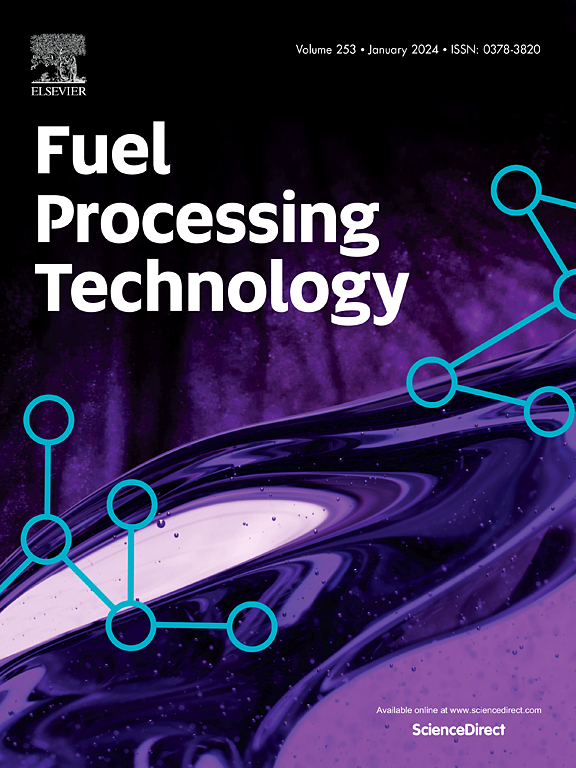调节硫化过程以减少一步催化合成含硫化学品的副产物
IF 7.2
2区 工程技术
Q1 CHEMISTRY, APPLIED
引用次数: 0
摘要
合成气和硫化氢(H2S)混合物一步法合成含硫化学品甲硫醇(CH3SH),在C1化学和硫资源回收利用方面具有广阔的应用前景。然而,由于存在多种反应物和以下各种竞争性副反应,定向调节合成目标含硫化学品的反应途径仍然具有挑战性。在此,我们提出了一种简单而简单的硫化过程依赖策略来调节K-MoS2催化剂的Mo-S(O)键强度,用于高选择性CO-to-CH3SH催化。活性测试、表征结果和原位DRIFTS技术表明,较慢的硫化升温速率和丰富还原的硫化气氛有利于k -插层1 T-MoS2相的形成,该相在CO分子中具有较弱的Mo-S(O)键。这种弱键模式有利于CO的非解离活化,有利于吸附的本文章由计算机程序翻译,如有差异,请以英文原文为准。

Modulating the sulfurization procedure to decrease by-product formation for one-step catalytic synthesis of sulfur-containing chemicals
The one-step synthesis of sulfur-containing chemicals, methanethiol (CH3SH), from syngas and hydrogen sullfide (H2S) mixtures shows the enormous potential for extending the application of both C1 chemistry and sulfur resource recycling and utilization. However, directionally regulating the reaction pathway for synthesizing target sulfur-containing chemicals remain challenging owing to the presence of multiple reactants and the following various competitive side reactions. Herein, we propose a facile and simple sulfurization procedure-dependent strategies to regulate the Mo-S(![]() O) bond strength of K-MoS2 catalysts for highly selective CO-to-CH3SH catalysis. The activity tests, the characterization results and in situ DRIFTS technique demonstrate that a slower sulfurization heating rate and abundant-reduced sulfurization atmosphere facilitate the formation of K-intercalated 1 T-MoS2 phase, which possesses a weaker Mo-S(
O) bond strength of K-MoS2 catalysts for highly selective CO-to-CH3SH catalysis. The activity tests, the characterization results and in situ DRIFTS technique demonstrate that a slower sulfurization heating rate and abundant-reduced sulfurization atmosphere facilitate the formation of K-intercalated 1 T-MoS2 phase, which possesses a weaker Mo-S(![]() O) bond than that of C
O) bond than that of C![]() O bond in CO molecules. This weakened bonding pattern is advantageous to the CO non-dissociative activation to from ⁎COS species, and the further hydrogenation of adsorbed ⁎COS and ⁎CHxS species to main product of CH3SH. Otherwise, the strong bonding of Mo-S(
O bond in CO molecules. This weakened bonding pattern is advantageous to the CO non-dissociative activation to from ⁎COS species, and the further hydrogenation of adsorbed ⁎COS and ⁎CHxS species to main product of CH3SH. Otherwise, the strong bonding of Mo-S(![]() O) bond with CO molecule over K-decorated 2H-MoS2 phase can lead to the breakage of C
O) bond with CO molecule over K-decorated 2H-MoS2 phase can lead to the breakage of C![]() O bond, promoting the formation of CHx species and the occurrence of methanation side reaction. This strategy could provide the useful guidance for the fine regulation of the main and side reaction pathway for producing important chemicals from carbon and sulfur basic materials.
O bond, promoting the formation of CHx species and the occurrence of methanation side reaction. This strategy could provide the useful guidance for the fine regulation of the main and side reaction pathway for producing important chemicals from carbon and sulfur basic materials.
求助全文
通过发布文献求助,成功后即可免费获取论文全文。
去求助
来源期刊

Fuel Processing Technology
工程技术-工程:化工
CiteScore
13.20
自引率
9.30%
发文量
398
审稿时长
26 days
期刊介绍:
Fuel Processing Technology (FPT) deals with the scientific and technological aspects of converting fossil and renewable resources to clean fuels, value-added chemicals, fuel-related advanced carbon materials and by-products. In addition to the traditional non-nuclear fossil fuels, biomass and wastes, papers on the integration of renewables such as solar and wind energy and energy storage into the fuel processing processes, as well as papers on the production and conversion of non-carbon-containing fuels such as hydrogen and ammonia, are also welcome. While chemical conversion is emphasized, papers on advanced physical conversion processes are also considered for publication in FPT. Papers on the fundamental aspects of fuel structure and properties will also be considered.
 求助内容:
求助内容: 应助结果提醒方式:
应助结果提醒方式:


